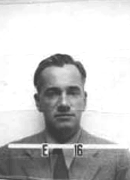Otto Frisch (1904-1979) was an Austrian-born physicist.
Frisch joined the Manhattan Project in 1943, but his most important contribution to the project came in 1940 in England. Frisch and Rudolf Peierls produced the Frisch-Peierls Memorandum, setting out the process by which an atomic explosion could be generated. The memorandum contained new calculations about the size of the critical mass of U-235 needed for an atomic bomb, accelerating British and U.S. efforts toward building the bomb. It also predicted the effects of the blast and fallout of an explosion.
In 1943, Frisch moved to the United States and joined physicists at Los Alamos to help build the bomb. Frisch was named leader of the Critical Assemblies group and was tasked with accurately determining the exact amount of enriched uranium which would be required to create the critical mass, the mass of uranium which would sustain a nuclear reaction.
In 1946, Frisch returned to England and was named head of the nuclear physics division of the Atomic Energy Research Establishment at Harwell.
Scientific Contributions
Frisch inherited his aunt Lise Meitner’s love of physics.
After several years of work at various laboratories in Germany, Frisch obtained a position in Hamburg under the Nobel Prize winning scientist Otto Stern. Here he produced novel work on the diffraction of atoms and proved that the magnetic moment of the proton was much larger than had been previously figured.
After the ascension of Adolf Hitler to the chancellorship of Germany in 1933, Frisch moved to London, England where he joined the faculty at Birkbeck College and worked with the physicist Patrick Maynard Stuart Blackett on cloud chamber technology and artificial radioactivity. Following his work with Blackett, Frisch joined Danish physicist Niels Bohr in Copenhagen, where he spent nearly five years studying nuclear physics.
Frisch was staying with his aunt Lise Meitner in Sweden in winter 1938 when she received the news that Otto Hahn and Fritz Strassmann in Berlin had discovered that the collision of a neutron with a uranium nucleus produced the element barium as one of its byproducts. Together, Frisch and Meitner hypothesized that the uranium nucleus had split in two. They coined the term “fission” to describe the process and published a paper that explained the phenomenon.





